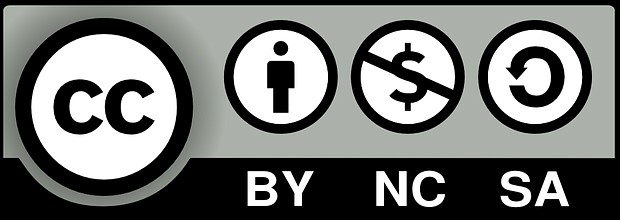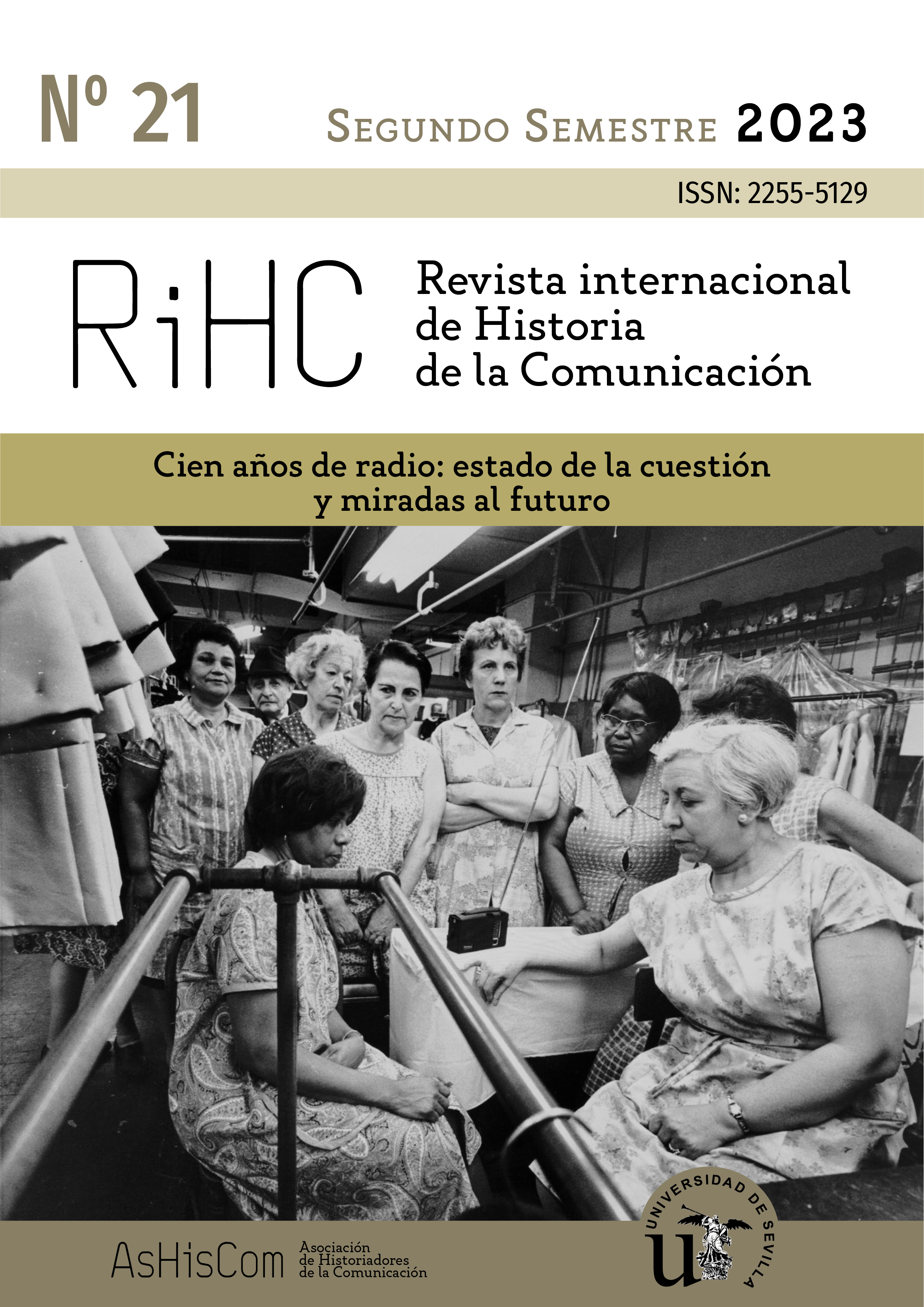La sátira gráfica en la revista política Enbata (1960-1975)
DOI:
https://doi.org/10.12795/RIHC.2023.i21.11Palabras clave:
Caricatura, chiste gráfico, prensa vasca, prensa francesa, sátiraResumen
Enbata es la primera revista francesa de ideología nacionalista vasca, nacida en Bayona (1960) como hebdomadario de la formación homónima, disuelta en 1974. Tras un año de silencio, la revista fue relanzada. El presente artículo estudia los chistes gráficos que se publicaron en Enbata desde 1960 hasta un año después de su interdicción. A través de un método analítico cuantitativo, se estudian los chistes por autoría, tamaño, posición en página y narrativa. Se identifican además las personalidades públicas caricaturizadas en ella. Se concluye que la caricatura fue un género ampliamente cultivado en Enbata, con una preferencia por la sátira que creció importantemente en 1975 como discurso contestatario. Beñat Amestoy ‘Etxebeltz’ fue su dibujante de referencia.
Descargas
Citas
ANGOULÊME [Mairie] (2018). Festival international de la bande dessinée. http://angouleme.fr/les-festivals/festival-international-de-la-bande-dessinee [Consulta: 16-07-2022].
ARANA, Edorta y ZUBIAGA, Mario (2019). Tiras que aflojan. El conflicto vasco en las viñetas. Edición electrónica. Bilbao: Universidad del País Vasco. https://lectura-unebook-es.ehu.idm.oclc.org/viewer/9788413190037/1 [Consulta: 27-04-2023]
ARBELBIDE, Xipri (1996). Enbata: abertzalegoaren historia Iparraldean. Irún (España): Fundación Kutxa.
ASURMENDI, Mikel (18-10-2009). Txuri-beltzezko ezkontza argia (Reportaje). Argia. http://argia.eus/argia-astekaria/2202/enbata-alda [Consulta: 16-03-2023].
AZPILICUETA, Jose Antonio (2000). La tira cómica humorística en prensa. Análisis de la evolución de una serie de 250 tiras de publicación semanal (Tesis doctoral inédita). Universidad del País Vasco, Lejona (España).
BORDERÍA ORTIZ, Enrique, MARTÍNEZ GALLEGO, Francesc-Andreu y GÓMEZ MOMPART, Josep Lluís (2010). La risa periodística: teoría, metodología e investigación en comunicación satírica. Valencia: Tirant lo Blanch
BILBAO, Isabelle (2013). Jean Ybarnegaray. Entre « petite patrie et grande patrie ». Bayona (Francia): Elkar.
BROCK, Frank (1993). Discours nationaliste et identité nationale basques: Enbata (1960-1992). (Tesis doctoral inédita). Universidad de Niza Sofía-Antipolis, Niza
COLOMBANI, Philippe. (1981). Notre Siècle en Caricature. París: Atlas.
CHRISTIN, Pierre, GAUMER, Patrick y MÉZIÈRES, Jean-Claude (2011). Pilote ou la naissance d’un art? Le journal de l’école de Paris du management, nº90, pp. 23-29. https://doi.org/10.3917/jepam.090.0023
DÍAZ NOCI, Javier (2012). Historia del periodismo vasco (1600-2010). Medika, nº13, pp. 1-261.
DUNY-PÉTRÉ, Arnaud y Ellande (2013). Souvenirs politiques de Arnaud Duny-Pétré (Blog). http://abertzale.over-blog.com [Consulta: 16-03-2013].
ECO, Umberto (1999). La estrategia de la ilusión (Traducción de Edgardo Oviedo). 3ª edición. Barcelona: Lumen. “Lo cómico y la regla”, pp. 164-168. https://hamamarino.files.wordpress.com/2018/12/eco-lo-comico-y-la-regla.pdf [Consulta: 25-10-2023]
ENBATA (1960). Pourquoi Enbata? Col. Les Cahiers d’Enbata. Bayona (Francia).
ENTRIALGO, Mauro (2011). Diario de un taller de humor gráfico e historieta costumbrista. Arbor, nº187, pp. 275–283. https://doi.org/10.3989/arbor.2011.2extran2124
ETCHEVERRY-AINCHART, Jon y Peio (2013). Le Mouvement Enbata. À la source de l’abertzaisme du Nord. Bayona (Francia): Elkar.
ETXEBELTZ (1999). Etxebeltzkeriak (1975-1999): 300 dessins d’Etxebeltz parus dans Enbata. Bayona (Francia): Gatuzain.
FEAVER, William (ed.) (1981). Masters of caricature: from Hogarth and Gillray to Scarfe and Levine. Nueva York: Alfred A. Knopf
GASCA, Luis y GUBERN, Román (1991). El discurso del comic. (2.ª ed.). Madrid: Cátedra.
GÓMEZ DE LA SERNA, Ramón (1975). Ismos. Madrid: Guadarrama
INFAME, Kike y BEGOÑA, Mikel (2017). Komikia. El Cómic Vasco (1975-2017). Bilbao: Diputación Foral de Bizkaia.
IZQUIERDO, Jean-Marie (2000). Le Pays Basque de France: la difficile maturation d’un sentiment nationaliste basque. París: Harmattan.
LANDART, Daniel (2013). Enbataren Zirimolan. Oroitzapenak. Bayona (Francia): Elkar
MARTIN, Laurent (2003). Le Canard enchaîné, un « objet politique mal identifié ». Revue d’histoire moderne & contemporaine, nº50(2), pp. 73-91. https://doi-org.ehu.idm.oclc.org/10.3917/rhmc.502.0073
MAZUR, Dan y DANNER, Alexander (2014). Comics: A global history. 1968 to the present. Nueva York: Thames Hudson.
PASCAL, Pierre (1993). BD passion: dessins de Danard et Pierre. Burdeos: Dossiers d’Aquitaine.
PAYS BASQUE [Communauté d’Agglomération] (s.f.). Les étapes. http://communaute-paysbasque.fr/la-communaute-pays-basque/le-territoire/lhistorique [Consulta: 25-04-2023]
REY CABERO, Enrique del; GOODRUM, Michael y MORLESÍN MELLADO, Josean (2021). Komikiak aztertzeko gida bat (Original: How to Study Comics & Graphic Novels). Bilbao: Universidad del País Vasco
RICHTER, Juan Pablo (1812). Teorías Estéticas. Madrid: Sociedad General Española de Librería
SAEZ DE ADANA HERRERO, F. M. (2014). Las tiras de prensa norteamericanas de finales del siglo XIX y principios del siglo XX como reflejo de la sociedad. Revista Internacional de Historia de la Comunicación, 2(3), pp. 20-47. https://doi.org/10.12795/RiHC.2014.i03.02
SKINN, Dez (2004). Comix: The underground revolution. Londres: Collins Brown.
SUD-OUEST [Publicité] (2023). Les journaux du Sud Ouest. Kit média 2023. http://storage.googleapis.com/cdn-sop-site-21/production/2023/03/Kit-media-JSO-2023.pdf [Consulta: 25-04-2023]
TUBAU, Iván (1987). Humor gráfico en la prensa del franquismo. Barcelona: Mitre.
VV. AA. (1981). Antología española del comix underground. Barcelona: Cúpula.
Descargas
Publicado
Cómo citar
Número
Sección
Licencia
Derechos de autor 2023 RIHC. Revista Internacional de Historia de la Comunicación

Esta obra está bajo una licencia internacional Creative Commons Atribución-NoComercial-CompartirIgual 4.0.
RiHC. Revista internacional de Historia de la Comunicación es una publicación de acceso libre, ofrece su contenido bajo el principio de que hacer disponible gratuitamente la investigación al publico apoya a un mayor intercambio de conocimiento global.
RIHC. Revista internacional de Historia de la Comunicación se adhiere a las diferentes iniciativas que promueven el acceso libre al conocimiento, por lo que todos los contenidos son de acceso libre y gratuito y se publican bajo licencia de Creative Commons Reconocimiento-NoComercial 4.0 Internacional.

En virtud de ello, los autores que publiquen en esta revista aceptan las siguientes condiciones:
Los autores conservan los derechos de autor y ceden a la revista el derecho de la primera publicación, con el trabajo registrado con la licencia de atribución de Creative Commons, que permite a terceros utilizar lo publicado siempre que mencionen la autoría del trabajo y a la primera publicación en esta revista.
Los autores pueden realizar otros acuerdos contractuales independientes y adicionales para la distribución no exclusiva de la versión del artículo publicado en esta revista (p. ej., incluirlo en un repositorio institucional o publicarlo en un libro) siempre que indiquen claramente que el trabajo se publicó por primera vez en esta revista.
Se permite y recomienda a los autores publicar su trabajo en Internet (por ejemplo en páginas institucionales o personales) ya que puede conducir a intercambios productivos y a una mayor y más rápida difusión del trabajo publicado (vea The Effect of Open Access).
No prevé moving wall o período de embargo
Debe utilizarse la versión de editor/PDF
La fuente editorial debe reconocerse



